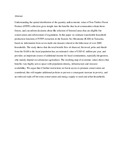| dc.contributor.author | Turner, R K | |
| dc.contributor.author | Vyamana, V G | |
| dc.contributor.author | Beukering, P van | |
| dc.contributor.author | Treue, T | |
| dc.contributor.author | Theilade, I | |
| dc.contributor.author | Ngaga, Y M | |
| dc.contributor.author | Meilby, H | |
| dc.contributor.author | Mbwambo, L | |
| dc.contributor.author | Madoffe, S S | |
| dc.contributor.author | Lund, J F | |
| dc.contributor.author | Kulindwa, K | |
| dc.contributor.author | Kilonzo, M | |
| dc.contributor.author | Kayharara, G | |
| dc.contributor.author | Kajembe, G C | |
| dc.date.accessioned | 2014-07-23T09:06:20Z | |
| dc.date.available | 2014-07-23T09:06:20Z | |
| dc.date.issued | 2014-01 | |
| dc.identifier.citation | Schaafsma, M., S. Morse-Jones, P. Posen, R. D. Swetnam, A. Balmford, I. J. Bateman, Neil David Burgess et al. "The importance of local forest benefits: Economic valuation of Non-Timber Forest Products in the Eastern Arc Mountains in Tanzania." Global Environmental Change 24 (2014): 295-305. | en_US |
| dc.identifier.uri | http://www.sciencedirect.com/science/article/pii/S0959378013002185 | |
| dc.identifier.uri | http://hdl.handle.net/11295/73266 | |
| dc.description.abstract | Understanding the spatial distribution of the quantity and economic value of Non-Timber Forest Product (NTFP) collection gives insight into the benefits that local communities obtain from forests, and can inform decisions about the selection of forested areas that are eligible for conservation and enforcement of regulations. In this paper we estimate transferable household production functions of NTFP extraction in the Eastern Arc Mountains (EAM) in Tanzania, based on information from seven multi-site datasets related to the behaviour of over 2000 households. The study shows that the total benefit flow of charcoal, firewood, poles and thatch from the EAM to the local population has an estimated value of USD 42 million per year, and provides an important source of additional income for local communities, especially the poorest, who mainly depend on subsistence agriculture. The resulting map of economic values shows that benefits vary highly across space with population density, infrastructure and resource availability. We argue that if further restrictions on forest access to promote conservation are considered, this will require additional policies to prevent a consequent increase in poverty, and an enforced trade-off between conservation and energy supply to rural and urban households. | en_US |
| dc.language.iso | en | en_US |
| dc.title | The importance of local forest benefits: Economic valuation of Non-Timber Forest Products in the Eastern Arc Mountains in Tanzania | en_US |
| dc.type | Article | en_US |
| dc.type.material | en | en_US |

